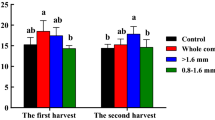Abstract
Leaves of eupatorium and lantana were separately composted in the laboratory in two phases. The first phase was run for 28 days at 50°C inside a hot-air oven and the second phase at room temperature for more than 5 months. After composting, the C/N ratio of the dry matter fell from 13.4 and 12.9 to 8.2 and 9.2 in eupatorium and lantana, respectively. The nitrogen contents of composted materials increased by 43 and 29% in eupatorium and lantana, respectively. In both composts, ammonium contents were much higher than nitrate contents. The light absorbance at 665 nm by acetone extracts decreased by 39% in eupatorium in comparison to 87% in lantana. The total extractable lipid phosphate contents decreased in both composts from about 4 μmol (during the mid-thermophilic phase) to less than 0.5 μmol lipid phosphate g–1 dry matter. After composting, germination bioassays with Chinese cabbage seeds showed nearly complete elimination of allelopathic potentials of both plant materials. However, the germination index of Dia sorghum indicated that eupatorium, but not lantana, compost still retained a significant inhibitory potential.
Similar content being viewed by others
Author information
Authors and Affiliations
Additional information
Received: 5 March 1997
Rights and permissions
About this article
Cite this article
Rajbanshi, S., Inubushi, K. Chemical and biochemical changes during laboratory-scale composting of allelopathic plant leaves (Eupatorium adenophorum and Lantana camara). Biol Fertil Soils 26, 66–71 (1997). https://doi.org/10.1007/s003740050344
Issue Date:
DOI: https://doi.org/10.1007/s003740050344




